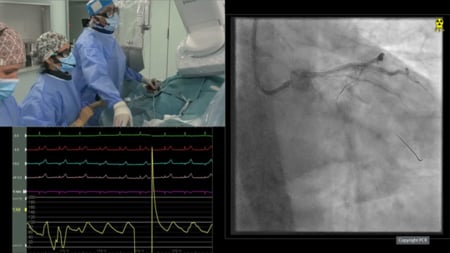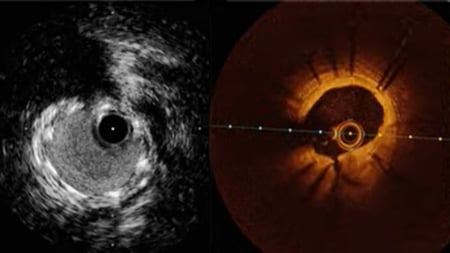Polymer-based or polymer-free stents in patients at high bleeding risk: ONYX ONE
Selected in New England Journal of Medicine by M. Alasnag
The objective of the ONYX ONE study was to compare the safety and effectiveness of the polymer-based or polymer-free stents in patients at high bleeding risk receiving 1 month of DAPT.
References
Authors
Windecker S, Latib A, Kedhi E, Kirtane AJ, Kandzari DE, Mehran R, Price MJ, Abizaid A, Simon DI, Worthley SG, Zaman A, Hudec M, Poliacikova P, Abdul Ghapar AKB, Selvaraj K, Petrov I, Mylotte D, Pinar E, Moreno R, Fabbiocchi F, Pasupati S, Kim HS, Aminian A, Tie C, Wlodarczak A, Hur SH, Marx SO, Jankovic I, Brar S, Bousquette L, Liu M, Stone GW; ONYX ONE Investigators.
Reference
DOI: 10.1056/NEJMoa1910021
Published
February 2020
Link
Read the abstractReviewer
My Comment
Why this study – the rationale/objective?
Balancing bleeding and ischemic events following percutaneous coronary interventions (PCI) has always been the Achilles' heel of PCI.
Recently Madhavan et al, published in the Journal of the American College of Cardiology pooled data from 19 randomized trials that included 25,032 patients demonstrating an ongoing 2% per year risk of stent-related events irrespective of the stent types that continues to climb over time. As such, there has been a general tendency to recommend longer duration of dual anti-platetlet therapy (DAPT). As newer generations of drug eluting stents (DES) become readily available, shorter DAPT regimens have become an option.
Trials such as the NORSTENT published in 2016 demonstrated lower rates of revascularization with DES compared to bare metal stents (16.5% vs. 19.8% and an absolute risk reduction of 3.3) at 6 years.
The LEADERS FREE trial compared the safety and efficacy of the biolimus-eluting BioFreedom drug-coated stent in elderly patients at high risk for bleeding who received one month of DAPT to BMS. The primary safety endpoint of cardiac death or myocardial infarction (MI) at 1 year for the bioFreedom stent vs. BMS was 8.6% vs. 12.3% and the primary efficacy endpoint at 1 year for target lesion revascularization (TLR) was 6.1% vs. 9.3% respectively.
The objective of the ONYX ONE study was to compare the safety and effectiveness of the polymer-based zotarolimus-eluting stent (ONYX) with the polymer-free umirolimus-coated stent in patients at high bleeding risk receiving 1 month of DAPT. These randomized data are necessary as higher bleeding risk individuals undergo PCI.
How was it executed – the methodology?
This is an international, randomized, single-blind trial, that compared Onyx with polymer-free umirolimus–coated stents in patients at high bleeding risk. Patients received 1 month of DAPT, followed by single anti-platelet therapy in both arms. The primary outcome for safety was a composite of death from cardiac causes, myocardial infarction, or stent thrombosis at 1 year. The principal secondary outcome was target-lesion failure, an effectiveness composite of death from cardiac causes, target-vessel myocardial infarction, or clinically indicated target-lesion revascularization. This study had a hierarchal non-inferiority design.
What is the main result?
A total of 1003 patients at high bleeding risk were randomly assigned to receive an Onyx stent and 993 assigned to receive a BioFreedom stent. At 1 year, the primary outcome was 17.1% of the Onyx arm and 16.9% of the BioFreedom arm (P=0.01 for non-inferiority).The principal secondary outcome was occurred in 17.6% of the Onyx arm and 17.4% of the BioFreedom arm (P=0.007 for non-inferiority). The mean age was 74 years and approximately one third were women. Non-ST elevation MI was observed in 27% and ST elevation MI in 5-6% of this cohort with approximately 50% of the enrolled patients having an acute coronary syndrome. Approximately one third had atrial fibrillation, 38% required long term oral anticoagulation after PCI, Left ventricular dysfunction (EF <35%) in 11.5%, prior PCI in 23% and prior coronary artery bypass grafting in 6-7%.

Study design for the ONYX ONE global trial
Critical reading and the relevance for clinical practice
Previously, studies such as the SMART CHOICE and STOP DAPT trials suggested that an abbreviated a three and one-month DAPT regimen is safe. It is notable that those cohorts were younger, lower risk, more likely to have stable disease (42% and 62% respectively) and intracoronary image guidance was used in >90% of the population.
The SENIOR (Short Duration of Dual Antiplatelet Therapy with Synergy II Stent in Patients Older Than 75 Year Undergoing Percutaneous Coronary Revascularization) trial used a contemporary DES and noted better outcomes compared to BMS with abbreviated DAPT in older patients.
This trial, ONYX ONE, adds to the body of evidence on the use of an abbreviated DAPT regimen for those who are not only at high bleeding risk, but also those with complex lesions and acute coronary syndromes. It is unclear whether image or physiology guidance helped optimize results in this study. It is also unclear whether more potent antiplatelet agents were used or whether the direct oral anticoagulants were prescribed for long term use in those with an indication. At this time, individual operators still need to weigh the totality of evidence with respect to balancing ischemic and bleeding risks. A patient-centered decision remains at the crux of this dilemma.







No comments yet!